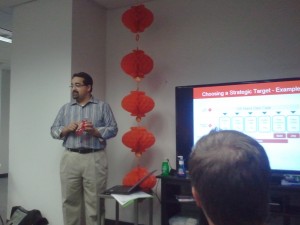building a consumer health product
Our workshop last night featured two great speakers who covered the topic Building a Consumer Health Product. Here are a few tidbits we think are worth sharing:
Sonny Jandial from P&G rocked our concept of building a brand around consumers.
Understand Your Consumer: Identify your specific buyer by asking, “What are the functional, emotional and experiential needs that drive and discriminate purchase of brands in product category?” P&G is extremely successful at tailoring the characteristics and design of their products, like dish soaps, to specific consumer personas. They take the time to figure out that some consumers are germ-obsessed while others want to enjoy a luxurious dishwashing experience with lavender scented soap. It is crucial to develop brands and packaging that deliver those different messages to their target groups. An application’s icon, name and branding have the same split second to grab the attention of potential users as someone strolling through the soap isle.
Understand the Power of Brand Purpose and Equity Sonny keyed in on how to boost the power of brand to pull in users. Clarify the key purpose and motivation of your product or app. Work through tough questions like: What does your brand believe? and Why do you exist? If these questions are left unanswered by your development team, potential users won’t pick up on the message either. After the big questions around values and meaning are answered, move into the details that set you apart from the competition. Identify your brand’s character/voice and discover what your brand stands for in hearts and minds of consumers.
Continually Iterate and Hone your Business Model Hypothesis Center your startup by constantly iterating your simple business plan. This refocus allows the group to work toward the same goal constantly and consistently. As large as P&G is, it can all be boiled down to one business model. Staying focused on this business plan allows for greater product quality, whether it is toothpaste or a fitness app.
John de Souza (President and CEO at MedHelp) pointed out key elements of designing consumer products for health.
Perfect Storm to Develop Health Apps. In the US, there is a growing need for healthcare and a depleting capacity to deliver to that need. We will need to adapt to keep ourselves healthier rather than rely on healthcare services. The tools that MedHelp and Rock Health startups are working with will enable users to take control. The evolution has begun; the #1 place people seek healthcare information is now the internet.
Healthcare Consumers When developing health products, it is essential to evaluate the specific needs of healthcare consumers. A lavender dish soap user most likely relies on different criteria to choose their healthcare provider and advice. It turns out consumers of healthcare look to experts mostly in the forms of doctors to get their answers. They also want to ask specific questions because they believe their particular symptoms and characteristics are unique. MedHelp used this insight to construct a forum that allows patients to ask their own questions and get expert advice, as seen in their headache forum.
Adapt Products to Data MedHelp develops systems to track users wellness behaviors such as sleep, mood, exercise and more. They continue to evaluate that data to understand how their consumers are using the product. From their data they adjust their products. One great example: users were inputting data into mobile devices rather than computers, but wanted to evaluate the trends on the computer. So they focused their attention on making simple-to-use mobile interfaces and evaluation tools and displays for the computer. A few other insights: users want their data to be secure, and backed-up in case they lose their phone, and they are willing to share their results.

